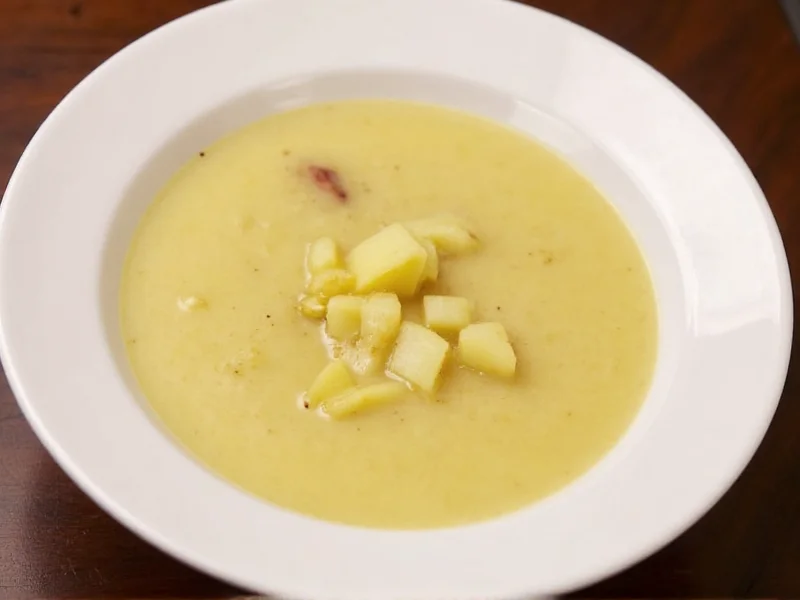Making delicious potato soup from scratch is easier than you might think. This versatile comfort food can be prepared with just a few basic ingredients and simple kitchen techniques. Whether you're looking for a quick weeknight dinner or an impressive starter for guests, mastering potato soup preparation opens doors to endless variations and customizations.
Essential Ingredients for Perfect Potato Soup
The foundation of great potato soup starts with quality ingredients. While recipes vary, these components form the base of a classic preparation:
| Ingredient | Quantity | Preparation Notes |
|---|---|---|
| Yukon Gold potatoes | 2 pounds | Peeled and diced into 1/2-inch cubes |
| Yellow onion | 1 medium | Finely chopped |
| Garlic cloves | 2 | Minced |
| Unsalted butter | 3 tablespoons | Or olive oil for dairy-free version |
| Vegetable or chicken broth | 4 cups | Low-sodium preferred |
| Whole milk or cream | 1 cup | For creaminess (optional) |
| Fresh thyme | 1 teaspoon | Dried works too (1/2 teaspoon) |
| Salt and pepper | To taste | Add gradually during cooking |
Step-by-Step Potato Soup Preparation
Follow these professional cooking techniques to create restaurant-quality potato soup at home. This method ensures perfect texture and balanced flavors every time.
- Sauté aromatics: Melt butter in a large pot over medium heat. Add onions and cook until translucent (about 5 minutes), then add garlic and cook for 1 minute until fragrant.
- Add potatoes and liquid: Stir in diced potatoes, broth, and thyme. Bring to a gentle boil, then reduce heat to maintain a simmer.
- Simmer until tender: Cover and cook for 15-20 minutes, or until potatoes are fork-tender. Do not overcook or potatoes may become waterlogged.
- Create creamy texture: For smooth soup, use an immersion blender directly in the pot until desired consistency is reached. For chunkier texture, blend only half the soup.
- Finish with dairy: Stir in milk or cream if using. Heat gently without boiling to prevent curdling. Season with salt and pepper to taste.
- Rest before serving: Let soup sit off heat for 5-10 minutes to allow flavors to meld before serving.
Pro Tips for Exceptional Potato Soup
Achieving perfect potato soup requires attention to detail. These professional cooking insights will elevate your results:
- Potato selection matters: Yukon Gold varieties contain the ideal starch-to-moisture ratio for creamy soups without needing excessive thickening.
- Control soup thickness: If too thin, simmer uncovered to reduce. If too thick, add small amounts of warm broth until desired consistency.
- Prevent curdling: When adding dairy, ensure soup isn't boiling and gradually temper the milk by adding small amounts of hot soup first.
- Layer flavors: Build depth by adding a parmesan rind during simmering or finishing with a splash of lemon juice to brighten flavors.
Popular Potato Soup Variations
Once you've mastered the basic technique, experiment with these delicious adaptations:
- Bacon potato soup: Cook 4-6 ounces of diced bacon before sautéing onions, using the rendered fat for cooking.
- Loaded baked potato soup: Top finished soup with shredded cheddar, crispy bacon, and chives for a hearty meal.
- Dairy-free version: Substitute coconut milk for cream and use olive oil instead of butter for a rich vegan option.
- Roasted garlic potato soup: Roast whole garlic cloves before adding to soup for deeper, sweeter flavor notes.
Storage and Reheating Guidelines
Potato soup stores well with proper handling:
- Cool completely before storing in airtight containers
- Refrigerate for up to 4 days or freeze for 2-3 months
- Reheat gently on stove over medium-low heat, adding small amounts of broth if needed
- Avoid microwaving large portions as it can create uneven heating and texture issues
Frequently Asked Questions
Can I make potato soup without cream?
Yes, you can create creamy potato soup without dairy by using alternative techniques. Simply blend the cooked potatoes thoroughly with the broth until smooth. For extra richness, add a peeled and diced russet potato (higher starch content) to the Yukon Golds, or incorporate a small amount of cooked white beans for creaminess without altering flavor significantly.
Why does my potato soup become watery after refrigeration?
Potato soup often thickens when cooled due to starch retrogradation, but may appear watery when reheated as the starch structure breaks down. To prevent this, slightly under-thicken your soup before cooling. When reheating watery soup, create a slurry with 1 tablespoon cornstarch mixed with 2 tablespoons cold water, then whisk into simmering soup until thickened.
What's the best potato variety for soup?
Yukon Gold potatoes are ideal for soup because they have medium starch content that creates natural creaminess when cooked and blended. They hold their shape better than russets during cooking but break down sufficiently to thicken the soup. Avoid waxy potatoes like red potatoes, which maintain too much structure and won't create a smooth texture.
How can I fix bland potato soup?
To enhance flavor in bland potato soup, try these techniques: add a parmesan cheese rind while simmering, finish with a splash of acid (lemon juice or vinegar), incorporate fresh herbs like chives or parsley, or stir in a small amount of Dijon mustard. For deeper flavor, sauté onions until golden brown rather than just translucent, or add a teaspoon of smoked paprika during cooking.
Can I make potato soup in a slow cooker?
Yes, potato soup works well in a slow cooker. Sauté onions and garlic first, then transfer to slow cooker with potatoes, broth, and seasonings. Cook on low for 6-7 hours or high for 3-4 hours until potatoes are tender. Blend partially for desired texture, then stir in dairy and heat through. The slow cooking process develops deeper flavors but requires careful monitoring near the end to prevent overcooking the potatoes.











 浙公网安备
33010002000092号
浙公网安备
33010002000092号 浙B2-20120091-4
浙B2-20120091-4